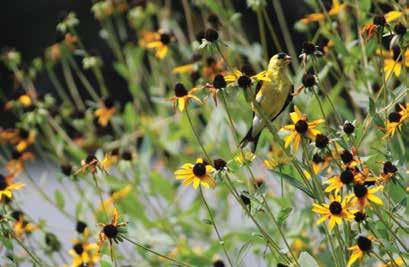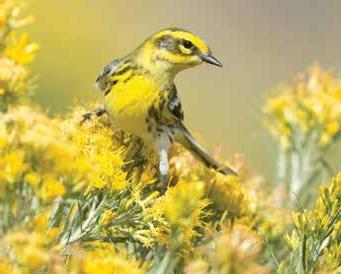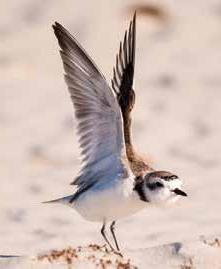
38 minute read
Grassland Birds
Meadows, carefully timed haying, and regenerative grazing are among the tools Northern Virginia farmers are using to bring back grassland birds in the most recently declared BirdScape.
by Amy Johnson and David Wiedenfeld
The Mid-Atlantic region is known for its symbolic Blue Ridge Mountains, bays and marshes, and flourishing deciduous forests. While these important habitats harbor some of North America’s most admired bird species, there’s one important ecosystem that’s often overlooked for bird conservation in these human-dominated landscapes — eastern grasslands.
The majority of eastern grasslands are on privately owned land under some form of agricultural management. They provide critical habitat for some of our nation’s most sharply declining species: For example, the Eastern Meadowlark, which has declined by more than 70 percent since the 1970s, relies upon private lands for 97 percent of its remaining habitat in the U.S. To conserve this iconic bird, it is essential for landowners, scientists, and conservation managers to collaborate on effective management of these landscapes. What’s happening in Virginia provides a hopeful example for how this can work elsewhere.
Rolling Out a Green Carpet for Grassland Birds
Nestled among the bucolic rolling hills just west of Washington, D.C., and coincidentally surrounding the home office of ABC in The Plains, Virginia, there exists a community of farmers, land managers, and homeowners who are collaborating with a team of Smithsonian scientists to help bring back grassland birds.
Virginia Working Landscapes (VWL), a program of the Smithsonian Conservation Biology Institute in Front Royal, collaborates with landowners, community scientists, universities, and other local partners to study the region’s biodiversity on private lands. Since 2010, the VWL team has surveyed more than 150 properties across 16 counties in Northern Virginia’s Piedmont and Shenandoah Valley. Together, these properties cover more than 80,000 acres, from hilly Loudoun County to the mountains
In VIRGINIA’S PIEDMONT:
bordering Augusta County. With much of this region under private ownership, it is an ideal landscape to gain a better understanding of how the actions of landowners influence the wildlife with which we share our grasslands. These properties now also form an integral part of a newly declared conservation zone, or BirdScape, established this year by ABC, VWL, and partners at the Piedmont Environmental Council (PEC). It’s called the Northern Virginia Piedmont and Shenandoah Valley BirdScape.
ABOVE: Northern Virginia farmers are helping to bring back grassland birds by maintaining meadows and timing hay harvests to accommodate nesting. Photo by Amy Johnson RIGHT: Bobolink nesting, from egg to fledgling. Photos by Bernadette Rigley
VIRGINIA’S PIEDMONT:
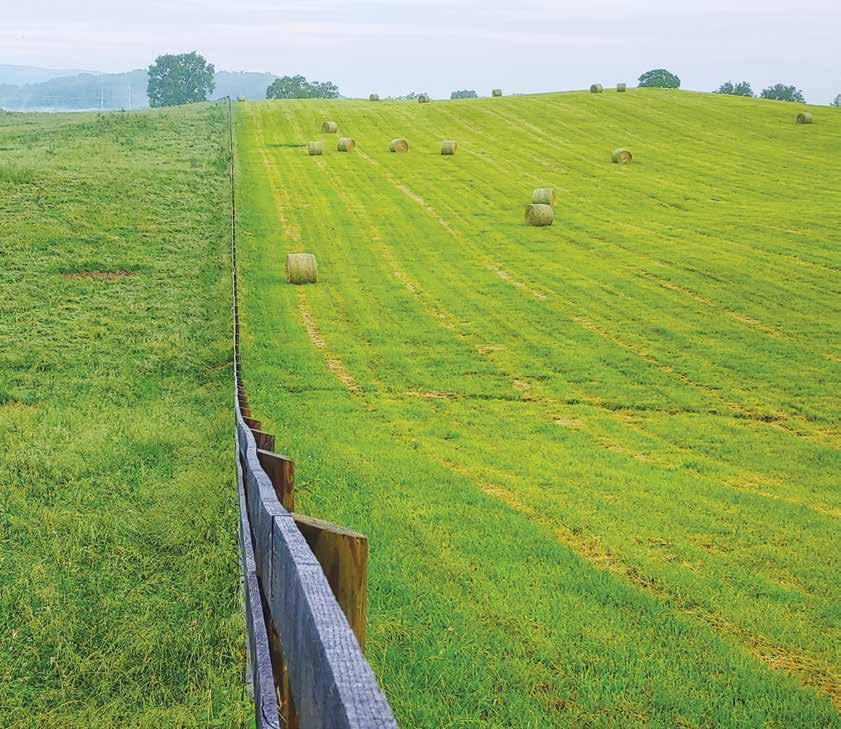
a Firmer Foothold for Grassland Birds
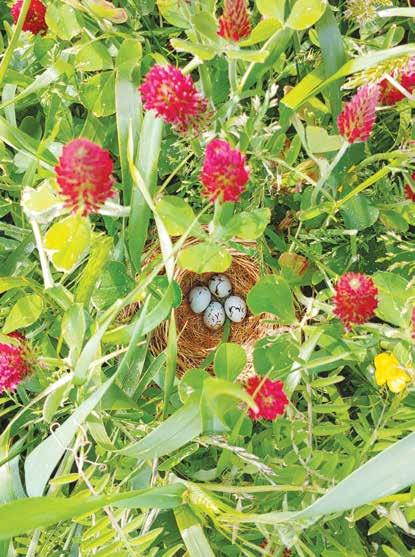
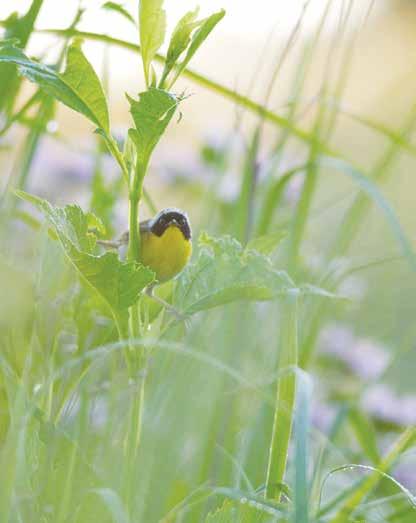
A BirdScape defines a focal area for conservation efforts, where partners can work together to address the issues affecting declining bird populations. Throughout the year, Virginia’s Piedmont grasslands are frequented by more than 100 bird species, including breeding and wintering grassland specialists that are in steep decline. Efforts are now underway to help study, protect, and restore some of the grasslands within the new BirdScape, which is only the second one east of the Appalachians and the first to focus on the Virginia Piedmont’s working grasslands.
Grass of the Past
From pre-European times up to the mid-1700s, lands between the Atlantic Ocean and Appalachian Mountains included some extensive and important grasslands and savannas. Many of these were maintained by frequent burning, either by Native Americans or natural, lightning-started fires, but they also occurred on shallow soils, balds, and barrens. The Virginia Piedmont grasslands, like other prairies, were home to a great many native plants, including endemic species, and even to large animals such as Elk and American Bison. But they were also breeding and wintering areas for many bird species, including some now mostly gone from the area.
European settlers in the 1600s and early 1700s plowed the grasslands and suppressed fires that had maintained the region’s prairies. By the early 1900s, only small patches of this habitat remained. Then, when agriculture began to shift to the Great Plains in the late 1800s and early 1900s, many farms were abandoned in the Piedmont.
But the prairies did not return. Today, few people living where they once stood have any idea they existed. Over the decades, properties not maintained in agriculture grew to tall, dark woodlands. Meanwhile, those utilized for grazing were mostly converted to nonnative grasses, robust introduced plants that provided forage for cattle, sheep, and horses. While some grassland bird species have adapted to these nonnative grasslands, the intensity with which they have been managed, combined with the loss of important native grasses and forbs, have contributed to the significant bird population declines we see today.
For example, Northern Bobwhites, Eastern Meadowlarks, and Grasshopper Sparrows have greatly declined in the northern Piedmont; Bobolinks and Savannah Sparrows have become rare breeders south of Pennsylvania; and some, like the Henslow’s Sparrow and the Loggerhead Shrike, a predatory songbird, are now only rare visitors.
VIRGINIA
WEST VIRGINIA MARYLAND
•Front Royal • Huntly • The Plains
•Washington
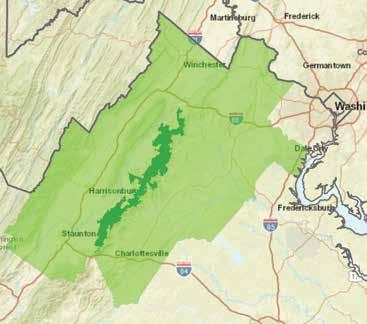
VIRGINIA
Northern Virginia Piedmont and Shenandoah Valley BirdScape
Shenandoah National Park
The ecological impacts of these losses could be devastating. As we lose diversity of species, we lose resiliency — making our ecosystems less adaptable to change.
Returning What Was Lost
In recent years, there has been growing interest in recovering some of what was lost in the Piedmont, with landowners trying both to rebuild native grasslands and regenerate existing working grasslands, while ensuring indefinite land protection through conservation easement programs. The new BirdScape will help to focus these efforts and provide a framework for bird conservation efforts.
Conservation is already at the forefront of many land management decisions in the region. For example, land protected by conservation easements in PEC’s ninecounty service area accounts for nearly 20 percent of the total land area, making this particular region “one of the best examples of private land conservation in the nation,” according to Michael Kane, PEC’s Director of Conservation and a key partner on the new BirdScape. This achievement reflects “a decades-long partnership between landowners and conservation organizations to preserve — for the benefit of the public at large — the natural resources, rural economy, history, and beauty of the Virginia Piedmont,” he adds.
Conservation easements will play an important role in establishing the new BirdScape, as permanent protection of farmland will help connect and preserve critical grassland habitat in perpetuity. In addition, the BirdScape partners will work together to study, document, and promote grassland management practices that benefit bird conservation, including rotational grazing, birdfriendly mowing, riparian buffers, and native grass and wildflower restorations.
Sowing the Seeds of Crops and Conservation
A prime example of how farms can make a huge difference for the region’s grassland birds sits in the heart of Washington, Virginia, where rich wildlife habitat is nurtured alongside rows of highly sought-after organic produce. The Farm at Sunnyside (http://thefarmatsunnyside.com/), owned by Nick and Gardiner Lapham, has converted nearly 40 acres of farmland into diverse native meadows supporting populations of Northern Bobwhites, Indigo Buntings, and Field Sparrows, to name a few. “Agriculturally driven land use change and management is the single greatest cause of biodiversity loss globally,” says Nick, a former member of ABC’s Board of Directors. “We want to be part of the effort to change that.”
Research conducted by VWL and their team of community scientists has shown that meadows like these support significantly higher densities of declining shrubland bird species such as Prairie Warblers, Yellow-breasted Chats, and Common Yellowthroats, compared with traditional hay fields and pastures.
“It’s been tremendously gratifying to see how habitat enhancements such as planting native meadows have, over a relatively short time period, resulted in expanded bird populations,” says Nick. By converting old fields into native meadows, farmlands like this contribute to biodiversity conservation by diversifying insect communities, boosting pollinator populations, and providing critical habitat for birds year-round. “It’s rewarding to see birds taking advantage of habitat in the agroscape,” Nick adds, “whether a flock of migrating Bobolinks using a field of spring cover crop or a family of rodent-devouring Barn Owls nesting in our silo.”
Of Birds and Beef
Just down the road in Huntly, farmers at Bean Hollow Grassfed (www.beanhollowgrassfed.com/) are collaborating with American Farmland Trust and VWL to study how regenerative grazing practices influence grassland birds. Now in its pilot year, this project is engaging producers in several Virginia counties in an effort to identify conservation metrics that could be used to create a market for bird-friendly beef.
Regenerative grazing is a form of agriculture that seeks to achieve improved soil health, boosted vegetation productivity, and extended grazing opportunities for livestock. There are also multiple ways that this approach can benefit birds. Earlier this year, VWL’s team of biologists ventured out to Bean Hollow Grassfed and several other farms in the area to monitor nests of some of the most vulnerable grassland bird species, including Eastern Meadowlarks, Bobolinks, and Grasshopper Sparrows. The team located and monitored more than 60 nests, providing promising data to be built upon over the next few years.
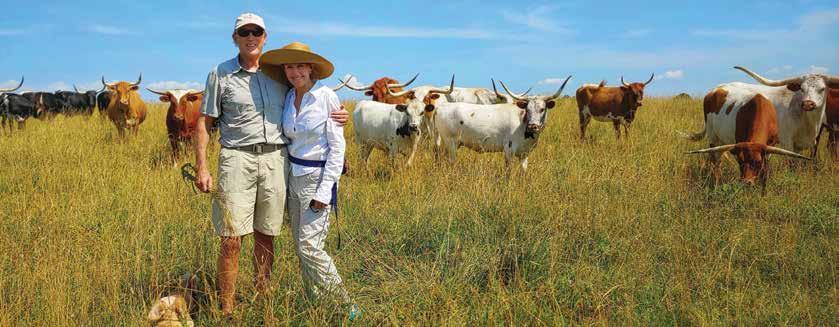
“The data collected by VWL scientists has given us backup for telling our story of using innovative grazing to restore the ecological health of the farm,” says Mike Sands, owner and operator of the farm, who worked with the VWL biologists to co-design the study. “This is of significant interest to our customers,” he adds.
Which Day to Hay?
In Front Royal, a gateway to Shenandoah National Park, Beatrice and Adie Von Gontard are graced with the bubbly songs of more than 100 Bobolinks that return to the farm each year. Owners of a 1,400-acre hay operation named Oxbow Farm, the couple has collaborated with VWL for ten years, dedicating time and acres to intricate ecological studies from bird-banding and bumblebee sampling to developing metrics for bird-friendly hay. While hay production is their primary business, the Von Gontards have recognized that the Oxbow fields host some of the region’s most productive populations of grassland birds. Just this year, for example, VWL biologists documented the first breeding record for Savannah Sparrows in the county.
TOP: Beatrice and Adie Von Gontard pose with their herd of Texas Longhorns at Oxbow Farm in Front Royal, VA. Photo by Amy Johnson The Von Gontards have dedicated several fields to the conservation of these delicate grassland species and changed the timing of hay harvests in some of their fields to accommodate the nesting season. “It’s rewarding to alter hay timing for birds because you’re giving them a chance to nest and fledge their young,” says Beatrice, who is often found waist-deep in grasses, assisting VWL biologists with their research. “And you get to see the incredible beauty of these birds in their breeding plumage, singing their melodious courtship songs and bringing food to their young. It’s one of the biggest thrills of a lifetime.”
It is the Von Gontards’ hope that by collaborating with organizations like VWL, they can contribute to research that lays the foundation for the widespread adoption of bird-friendly hay practices. “What I’ve learned is, when you farm the land in a sustainable way, you increase the diversity of species, which, in turn, makes the land a healthier and more vibrant place to live,” Beatrice adds.
Conservation Is Year-Round
Adopting conservation practices that benefit breeding grassland birds is essential for their recovery and conservation, but we mustn’t ignore the needs of these birds the rest of the year. Many studies hypothesize that what happens on wintering grounds likely contributes to the decline of many of these species, yet studies of grassland birds on their wintering grounds remain limited. To help fill this gap, VWL has been collaborating with landowners to explore how winter management of fields impacts birds wintering in Virginia grasslands.
Using results from this research, the region’s landowners now have the means to understand how they can optimize grassland habitat, both for resident and migrant
species. For example, Bruce and Susan Jones of Washington, Virginia, own Jones Nature Preserve (https:// jonesnaturepreserve.wordpress.com/), which they carefully manage to maximize biodiversity on their property. Most of the fields there are composed of native grasses that VWL research has shown to provide critical habitat to birds overwintering in grasslands.
When left unmowed through the winter, native grasses provide thick cover, protecting birds from predators and the elements. They also maintain an abundance of nutrient-packed seeds that can sustain birds through the worst winter storms. “As the taller warm-season grasses tend to topple from the wind and snow, the seed heads stay low, and that makes for a ready food supply that also provides safety, warmth, and cover,” says Bruce, who regularly hosts workshops in collaboration with VWL and PEC to help educate community members about the importance of native plants for birds and other wildlife.
Species never or rarely seen in the area during breeding season, like Savannah, Fox, and American Tree Sparrows, flock to these fields to take advantage of the winter seed bounty. In addition, VWL biologists have documented Northern Harriers and Short-eared Owls using fields like these to roost, among sturdy clumps of native grasses that form protective dome-like shelters. While we often think of winter as the silent season for birding, places like Jones Nature Preserve remind us that our lives needn’t be devoid of birds through winter — if we build it, they will come.
TOP: The Smithsonian‘s Amy Johnson and landowner Bruce Jones meander through the native grass meadows at Jones Nature Preserve in Washington, VA, where the Virginia Working Landscapes team conducts some of their grassland bird research. Photo by Olivia Cosby TOP RIGHT: Wintering sparrows, like this American Tree Sparrow, flock to the native grass meadows at Jones Nature Preserve in Washington, VA, to forage for seeds throughout the winter months. Photo by Amy Johnson
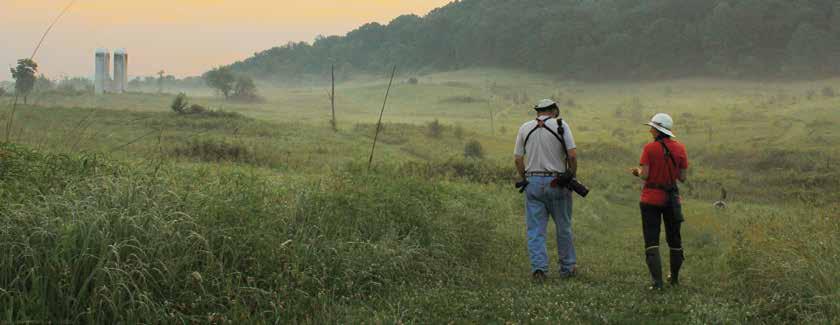
Sharing the Work
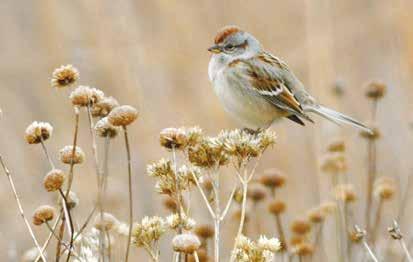
The new Northern Virginia Piedmont and Shenandoah Valley BirdScape shines a light on the landscape scale and focus of efforts by VWL, PEC, private landowners, and other partners promoting bird conservation in Virginia’s Piedmont grasslands. That this BirdScape includes ABC’s own home office puts ABC directly in the picture, but another distinction is that this is the first in the network to be proposed not by ABC but one of its partners. This added momentum underscores the goal of the network — all working together for one objective: bird conservation.
Amy Johnson is a Conservation Ecologist at the Smithsonian Conservation Biology Institute and Program Director of Virginia Working Landscapes.
David Wiedenfeld is ABC’s Senior Conservation Scientist.
PARROT PARADOX: The Unprotected, Endangered Red-crowned Parrot
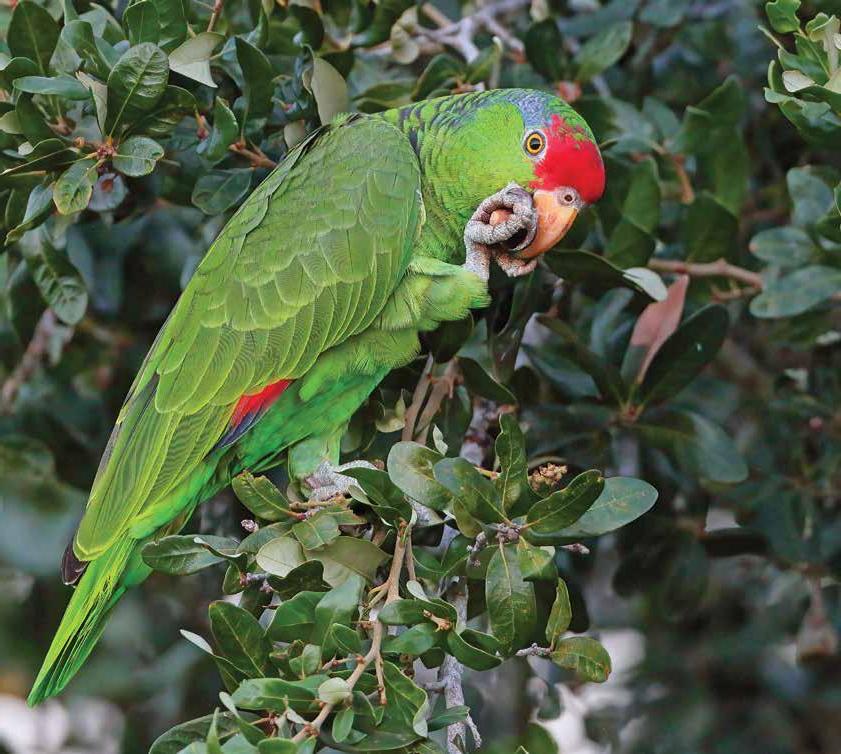
How humanity threatens, benefits, and can save an endearing, rangerestricted bird.
by Howard Youth
The Red-crowned Parrot could be a poster-bird for the travails facing wild parrot populations around the world. Pummeled for decades by the one-two punch of habitat loss and capture for the bird trade, this chunky green bird with red cap and wing flashes has vanished from 50 to 85 percent of its original range, its population down an estimated 95 percent. Not surprisingly, the International Union for Conservation of Nature (IUCN) lists the species as Endangered. But there is a silver lining: Usually a bird of remaining wild,
scrub-forest habitat in its small range in northeastern Mexico, this parrot now also occupies South Texas suburbs in a big way. Scientists studying the birds both north and south of the border hope that by tapping into our affection for these colorful, intelligent birds — and appreciating them as wild birds, not prospective pets — that the Red-crowned Parrot can be saved, both in town and country.
Birds of the Burbs
In the subtropical climate of Texas’s Lower Rio Grande Valley (LRGV), suburban yards, shopping centers, and a city park now shelter a robust Red-crowned Parrot population based in four cities — Brownsville, Harlingen, McAllen, and Weslaco.
“It’s clear that these parrots want what the people want,” says Simon Kiacz, a Texas A&M Ph.D. graduate student who has been studying the South Texas birds since 2016 as part of the Tejano Parrot Project, working with volunteers to study the region’s four roosts. Kiacz wrote his dissertation on these birds and coauthored the only definitive recent study of the population, published in the journal Bird Conservation International in 2020.
“Every single nest, roost, and feeding tree we have confirmed has either been planted or facilitated by a person,” says Donald J. Brightsmith, a Texas A&M biology professor and coauthor of the paper. “That’s completely the opposite of most every bird population we’re trying to protect in remnant populations.”
“I don’t know of any evidence that we have flocks of them outside the urban interface, and I don’t know of any anecdotes or complaints or studies from agricultural folks saying the parrots damage anything,” adds Tony Henehan, another of the paper’s coauthors, who is a wildlife biologist with the Texas Parks and Wildlife Department. Henehan coordinates quarterly parrot roost counts in the LRGV, most of which are carried out by local volunteers recruited by two groups, Arroyo Colorado Audubon and Texas Master Naturalists.
The current LRGV population is estimated at about 700 birds, remaining steady the last three to five years, after increasing for decades. Roughly 110 miles from the northern limit of the bird’s Mexican range, this satellite population is considered by the paper’s authors to be “an
LEFT: Dexterous and surprisingly well camouflaged as they quietly forage in trees, Red-crowned Parrots have proven they can live alongside people, as long as people can “live and let live.” Photo by Greg Homel, Natural Elements Productions important reservoir for this endangered species.” Redcrowns are now found in other parts of the U.S. as well, including Hawai‘i, Puerto Rico, Florida, and especially southern California, home to approximately 3,700. All together, the total U.S. population, estimated at roughly 4,700 birds, may outnumber the estimated remaining wild Mexican population of 2,000 to 4,300 adults.
The four large South Texas roost sites are occupied much of the year, ebbing during nesting season. The Brownsville roost remains more or less static, but participants in the other three roosts switch locations from time to time. Each day, the birds gather at dusk in noisy congregations, then silently settle at roost perches by nightfall. Just before sunrise, they reverse the process. The birds’ raucous calls are hard to ignore. “But once the birds are quiet and they’re done settling in to roost, you wouldn’t know they’re in the trees right over your head,” says Kiacz. “People will roll right up to these birds and park their cars, or the pizza guy stops by, and they have no idea there are 200 birds right above their heads.”
What do local residents think of their green-feathered neighbors? “Overall, there’s definitely a positive view of these birds,” says Kiacz. “The people who have them nesting and roosting in their yards have a really strong connection with them. Although sometimes you see people obviously just woken by the birds, who come out clapping their hands.”
Origins of the Species (in Texas)
Many have assumed the South Texas Redcrown population originated solely from escaped cagebirds, but due to the area’s close proximity to the native range in northeastern Mexico, there’s been decades of debate about whether or not natural pioneers form part of the LRGV birds’ legacy. All the sources interviewed for this article believe the population has included at least some Mexican birds that flew there themselves. Jesús Franco, an ABC conservation biologist and Assistant Coordinator of a binational bird conservation partnership called the Rio Grande Joint Venture (RGJV), lives in South Texas. He has studied the species both there and in Mexico, in submontane forest on the eastern flanks of the Sierra Madre Oriental mountain range.
Franco explains why he believes not all Redcrowns originate from introduced birds: “In Mexico, the Sierra Madre Oriental forms a natural barrier that can channel birds like the parrots, if they have to move, northward and close to the U.S. border. This can help one safely assume that
Map showing the four Lower Rio Grande Valley cities with Red-crowned Parrot roosts and their proximity to the northern portion of the species' Mexican range (shaded in gray). Monterrey, Mexico also has a population.
Weslaco McAllen Harlingen
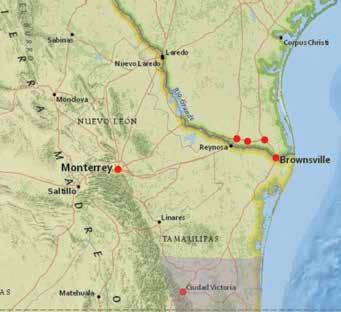
MEXICO
when the right conditions came together, it could have been natural dispersal that occurred along this corridor,” he says. “But there’s currently no way to prove the origins one way or another. At least, no one has done it yet.”
Although not considered migratory, Red-crowned Parrots sometimes disperse, particularly outside the breeding season. This usually happens in times of severe winter weather or drought, when the birds may wander relatively long distances seeking sustenance. For their paper, Kiacz and his colleagues collected past records, writing: “In 1885, the Galveston Daily News reported that travelers were seeing flocks of parrots as close as 34 km (21 miles) south of Brownsville, Texas. Also in 1885, a south Texas newspaper reported flocks of parrots north of Brownsville and noted this as the first instance of these birds being seen in Texas.” The once-abundant Redcrown is the species most likely seen. Occasional LRGV reports of parrots followed, but the first nesting-season sightings there came in 1976, followed by confirmed nesting in Harlingen in 1985. By the early 1990s, the parrots nested in all four roost-site cities. Why the sudden uptick in birds in the late 20th century? Most experts believe that this jump was fueled by the crossborder bird trade. According to sources cited in Kiacz and his colleagues’ paper, through the 1970s and early 1980s, the flow of legally and illegally transported birds into the U.S. is estimated to have included more than 30,000 Redcrowns — more than six times the current total estimate for the Mexican population — most coming through South Texas. Subsequent legislation banning wild-parrot imports, tighter import controls in general, and reduced wild Mexican parrot populations mean that few if any illegal birds arrive now.
But in their paper, Kiacz, Brightsmith, and their colleagues posit that the winter of 1983-1984 might also have sparked natural changes. Then, an historic freeze in the region likely forced Mexican birds outside their normal range, with some heading north. Meanwhile, the same freeze killed large numbers of palms in South Texas, leaving legions of dead, standing nest trees for arriving, cavity-nesting colonizers.
Long assumed by many to be nonnative and sedentary, U.S. Red-crowned Parrots sit in legal limbo, lacking federal protections other small bird populations garner under the Endangered Species Act (ESA) and Migratory Bird Treaty Act. The species was passed up for ESA listing
PARROTS of the USA
The popularity of parrots as pets has helped spawn naturalized populations, particularly in warmer parts of the country. Long-lived social creatures, parrots often prove challenging pets, requiring more space and care than many owners anticipate. Many escape captivity or are released deliberately.
About two dozen parrot species have U.S. breeding populations. The Monk Parakeet is considered a pest by electric utilities because, unlike most other parrots, this species builds bulky, communal nests that, when stuffed into electrical gear, pose the threat of power outages and fire. So far, the mostly urban naturalized parrots do not seem to compete heavily with native cavitynesting species.
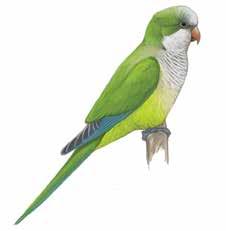
Here, eight of the most populous species are listed, as are two native species that have vanished — one extinct, the other extirpated (gone from the region).
in 2019. Although the U.S. Fish and Wildlife Service recognizes the South Texas population as native, it declared listing it was not justified because the U.S. population was not declining and because the rate of habitat loss in Mexico has not been as high as in prior decades.
The state of Texas, meanwhile, now classifies the parrot as native, after reviewers considered historical parrot records in the LRGV, as well as the likely pathway Mexican birds take north when dispersing. Texas is also in the process of modifying its threatened species list, and likely will soon declare the Redcrown “threatened.”
A source of local pride, the Red-crowned Parrot is protected in the four roost cities. Brownsville has even designated it the city’s official bird, its likeness appearing on a prominent underpass and elsewhere. The parrots help generate hundreds of thousands of dollars in local income, drawing visiting birders who descend upon the region each year to attend several annual birding festivals or to chase “border birds” on their own.
Eyeing the Future
Among the goals of the South Texas study and roost counts was to determine the Redcrown population’s size and health, and to start to understand how to secure its future in a rapidly developing region. The results affirmed that even with urban parrots, nothing can be taken for granted.
“The population really increased drastically for many years, but once we started doing really good counts on them, we see the population has leveled off the last three to four years,” says Texas A&M’s Brightsmith. “This begs the question: Why explode for so long and level off? Perhaps they are not necessarily in equilibrium with their habitat, but getting close? Is poaching enough of a problem in Texas to depress the population? Or are there nestsite limitations? We didn’t think so, but if you throw out the other stuff, it’s one thing that’s left in the basket.”
“I think the really big threat they face is the loss of nest sites,” says Texas Parks and Wildlife’s Henehan. “The parrots seem to prefer palm trees, but one of the things that happens to dead trees in urban areas is that they get cut down. They are considered ugly, or they might hurt someone or a building.”
Conserving dead standing trees and making careful landscaping choices will be important components of any plan to help the parrots. “The plants that homeowners and municipal governments are putting on their lands — these are the future habitat for these birds,” adds Brightsmith. Many Texas Redcrowns nest in cavities in introduced fan palms of the genus Washingtonia, a now-iconic regional tree accenting towns and farm-field borders. “If you don’t provide these,” says Brightsmith, “you’re not providing future nest sites for the species.”
Meanwhile, poachers target some of the remaining nest trees. During the study, Kiacz and others regularly noted telltale marks and cuttings in trees indicating the removal of young birds by people. Locally captured birds are sometimes seen being sold at local flea markets.
The parrots face other suburban threats as well. “I’m concerned about feral cats,” Henehan says. “I’ve seen cats on rooftops trying to grab parrots. There are sponsored cat colonies in some communities, and feral cats are just
Monk Parakeet
Native to temperate southern South America, the Monk Parakeet is the country’s most widely distributed, and likely most populous, naturalized parrot. More than half the U.S. population occurs in Florida, but the species and its bulky, communal nests are also found in several major Texas cities, New York City, Connecticut, California, Chicago, and elsewhere. Nanday Parakeet Populations of this South American species have steadily grown in Florida and California.

Red-crowned Parrot Endemic to northeastern Mexico, this species now has urban breeding populations in South Texas, California, Florida, Puerto Rico, Hawai’i, and Monterrey, Mexico. (Shown on p. 30.) Green Parakeet Native to Mexico and Central America, more than 1,000 birds also occur in a naturalized South Texas population that may include some natural stragglers.

so widespread down here that I wouldn’t be surprised if some part of their diet consists of parrots.” In addition, the birds face competition for available nest sites from other birds, including the plentiful Black-bellied Whistling-Duck, the also-naturalized Green Parakeet, and, uncommonly, squirrels.

Although they face challenges, the South Texas Redcrowned Parrot population has many local fans and likely will persist, and hopefully grow once again, alongside the LRGV’s expanding human population. But what about the core population in northeastern Mexico? Luckily, ABC and partners have been looking into that, studying how communities can embrace and protect these birds.
South of the Border
Concerned about the species’ dwindling numbers and shrinking range in northeastern Mexico, researchers from ABC, the RGJV, and Mexican partner Terra Asesoría Ambiental studied the parrots in four municipalities in Tamaulipas state from 2017 to 2019. Their goals were to determine the species’ status in a large portion of the Mexican range, to identify key parrot hotspots, and to provide a foundation for a recently drawn-up conservation plan, which has since been produced. During the study, researchers and local volunteers counted Redcrowned Parrots at 34 roost sites, tallying 1,789 birds in a four-county area.
“After two years of field monitoring, we now have a conservation plan and have identified the sites where we need to prioritize the work,” says ABC’s Franco. “But the thing you don’t want to see is a conservation plan living on the bookshelf. Therefore, I’m super-excited to see ABC stepping up to the plate to provide the first round of funding to begin the implementation of the conservation action plan that we’ve made for the Red-crowned Parrot in Tamaulipas.”
With an agreement recently signed with Mexican partner Pronatura Noreste, ABC plans to take action starting in 2021. The Tamaulipas State Commission for Parks and Biodiversity will also join in these efforts. Part of the plan is to work with residents in each community to train and certify them as environmental interpreters/guards. “The main objective is to strengthen local capacity to conduct ecotourism and birding activities, as well as to assist local enforcement agencies by conducting monitoring and surveillance activities around nesting areas,” says Franco.
To help support this project, ABC and Pronatura Noreste are partnering with Defenders of Wildlife Mexico to produce educational posters and bird identification pamphlets promoting birdwatching as an alternative source of income and raising awareness of wildlife trafficking’s negative impacts. The partners are also exploring other economic opportunities that will benefit
PARROTS of the USA
Rosy-faced Lovebird Roughly the length of a Song Sparrow, this small southern African parrot has a firm foothold in Phoenix, Arizona, where a half-day census in 2010 tallied more than 900 birds.
White-winged Parakeet This small, tapertailed South American species nests in small populations in South Florida and California. Rose-ringed Parakeet Small populations of this Asian species breed in southern California and Florida; thousands nest in Hawai‘i. The world’s most widely distributed naturalized parrot, the Rose-ringed also breeds in at least ten European nations, among others.
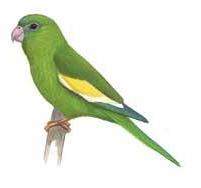
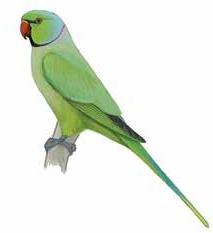
residents, such as finding new ways to market local crafts and food to visitors.
While most of Mexico’s Redcrowns keep to wild areas, there are noteworthy exceptions. The large city of Monterrey has a significant population. And during their study in the heart of the bird’s Mexican range, Franco and his colleagues tallied a stunning 72 Red-crowned Parrot nests in Hidalgo, a small community of 10,000 people not far from the large city of Ciudad Victoria. “These birds often live in native habitat close to urban areas,” Franco says, “but in a square in a tiny, itty bitty town, we recorded the highest nesting density we know of.”
Franco believes one reason the birds persist there is that the local people are watching out for them, discouraging poachers who might venture in from out of town. This raises the question: What if tomorrow, people stopped capturing or otherwise harassing wild, endangered parrots? “This is a really good example,” says Franco, “of what these birds can do when they find what they need and are basically left alone.”
Mostly a bird of natural habitats in northern Mexico, the Red-crowned Parrot is very much a bird of the burbs in the U.S. Photo by Simon Kiacz
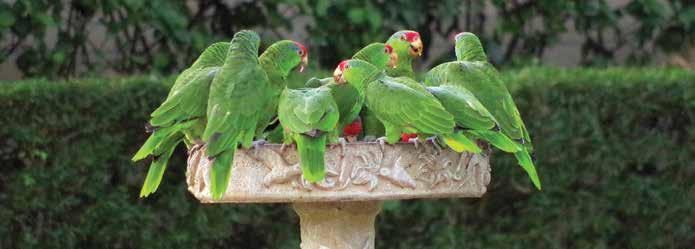
Working together in two countries, conservationists hope this kind of parrot-friendly coexistence will become more commonplace. If successful, efforts to save the Redcrowned Parrot will not only ensure that these beloved birds remain — but also inspire other efforts to save many other declining parrots through a blend of careful study, planning, and local buy-in.
ABC would like to thank the Texas Parks and Wildlife Department, the U.S. Fish and Wildlife Service, and Kathleen Burger and Glen Gerada for their generous support.
Howard Youth is ABC’s Senior Writer/Editor.
Carolina Parakeet Once native to the southeastern United States, this large parakeet’s extinction followed widespread habitat loss and shooting. The bird was gone from the wild by 1905; the last captive bird died in a zoo in 1918. Yellow-chevroned Parakeet Small populations of this South American bird nest in lushly landscaped South Florida urban areas, and also in California. Thick-billed Parrot This Endangered bird of mountainous pine forest in western Mexico used to occur in Arizona, but has not been seen there since 1938. A reintroduction program from 1986-1993 was unsuccessful.
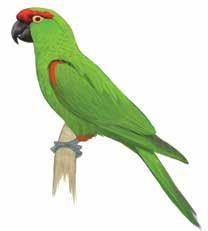
MOSQUITO BIRTH CONTROL
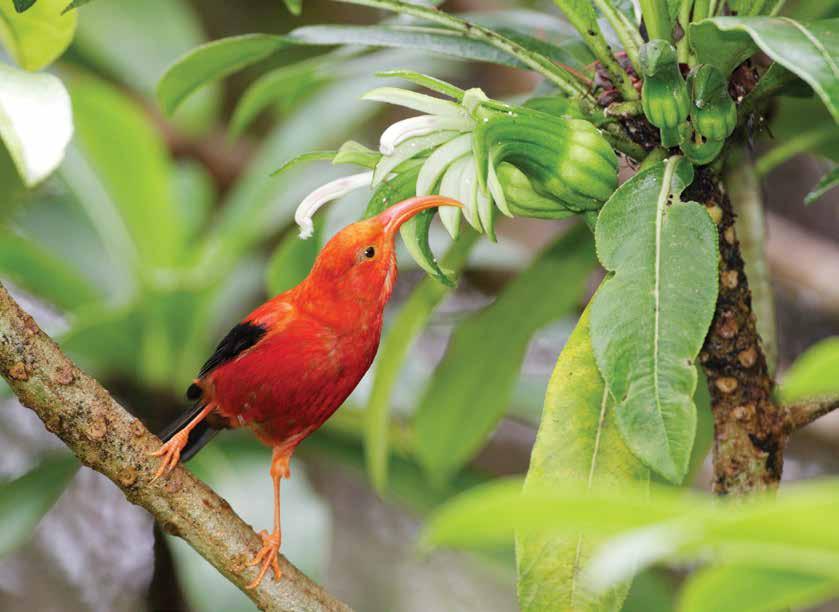
In this Q&A, ABC’s Hawai‘i Program Director Chris Farmer explains why Hawaiian honeycreepers are in such dire straits, and how ABC and partners’ urgent initiative aims to save them using Wolbachia — a tested tool in the fight to protect human health.
and the Fight to Save Hawaiian Honeycreepers
Why is Hawai‘i sometimes called “the bird extinction capital of the world”?
CF: Because about 15 percent of the world’s bird extinctions have occurred here over the last 700 years. We have lost about 67 percent of all Hawaiian birds since humans arrived. Of the remaining native bird species, 78 percent are federally listed — including 11 species that have not been detected in decades and are likely already extinct. The extinction threat in Hawai‘i is orders of magnitude more severe than for imperiled mainland birds. To give you an idea, there are 11 endangered songbird species here that have a combined population of approximately 10,000 birds, far less than the estimated population of the Red-cockaded Woodpecker of the southeastern U.S.
How many Hawaiian honeycreepers remain and why are they unique?
CF: Hawai‘i is one of the world’s most isolated island chains. The distance, spectacular geography, and elevational range here provided an abundance of ecological niches into which newly arrived birds could expand. The
endemic Hawaiian honeycreepers are world renowned for their incredible array of bill morphology and plumages. These unique birds arose from a Eurasian rosefinch species that arrived around 5.7 million years ago — before the formation of O‘ahu or any of the younger islands. Detecting avian fossils and pre-fossils in highly active volcanic islands is difficult, but the current estimate is that there were at least 59 different honeycreeper species — of which only 17 survive today.
Why are mosquitoes and the diseases they carry so lethal to Hawaiian honeycreepers?
CF: Because Hawai‘i is so distant from the continents, many creatures and pathogens never arrived here, including mosquitoes and avian malaria. Because the birds had millions of years without exposure to the disease, they lost whatever immunity they had by the time humans brought mosquitoes and malaria to the islands. Some honeycreepers, like ‘I‘iwi, are highly susceptible: One bite from an infected mosquito can cause death. The situation is similar for the Kiwikiu (Maui Parrotbill) that were translocated last year and, sadly, died from avian malaria.
How does climate change contribute to the rapid decline in remaining Hawaiian honeycreepers?
CF: Mosquitoes and the avian malaria parasite need warm temperatures to reproduce, so they were historically limited to the warmer, low elevations of Hawai‘i. The remaining native bird species mostly survive above this “mosquito zone,” in high-elevation forests. However, as temperatures warm, the mosquitoes are able to move up the mountain; the malaria parasite is also able to survive at these elevations, leading to increased disease transmission in previously safe habitats. Increased mosquito density is already being seen on Kaua‘i and Maui, and endemic honeycreepers on both islands are rapidly declining.
What are ABC and its partners doing to save Hawaiian honeycreepers?
CF: The avian disease/mosquito/native bird relationship has been known since the late 1960s, but there were no landscape-scale solutions possible until recently.
Building upon tremendous research and applications aimed at protecting human health, ABC and our local partners have been working on a method to control mosquito populations across thousands of acres to save the birds from extinction. We are mobilizing to use Wolbachia, common bacteria already present in Hawai‘i (and present in over 60 percent of all insects). Male mosquitoes raised in labs from eggs injected with a fertility-altering Wolbachia strain will be released into the wild. Using this strategy, it is possible to prevent the mosquitoes from reproducing: These males do not bite people, but they effectively find and mate with wild, fertile females. Resulting eggs do not hatch. This method is being used in 14 countries, including the United States, to control human diseases.
How is this mosquito-control effort different from those using genetically modified mosquitoes?
CF: There is an immense amount of research on mosquitoes and disease for human health, including many different types of modifications of the mosquito’s genome. All of these methods modify the mosquitoes’ actual DNA, and the changes can be passed on to their offspring, to varying degrees. The Wolbachia method does not alter the mosquito’s genome. Using Wolbachia is not self-sustaining, and cannot be passed on to future generations. There will need to be continued releases into the habitat to protect Hawai‘i’s birds. Although this will increase the costs, it gives the scientists more control over the program, and if this method knocks back mosquito populations, it will save many species from extinction.
What’s next?
CF: ABC and our partners are collecting data on mosquito abundance, distribution, and movement, and will be using this to construct a successful implementation strategy. We have also begun community engagement and outreach, because having local support is necessary for any success. The group is also working to develop and test the efficacy of the Wolbachia mosquitoes to prevent successful mosquito breeding. These results will inform the regulatory process, which includes securing all the required state and federal permits for the project. Learn more: bit.ly/HawaiiMosquitoes
This project is generously supported by the National Fish and Wildlife Foundation; U.S. Fish and Wildlife Service, Science Applications Program and Recovery Implementation Funds; The Dorrance Family Foundation; Weissman Family Foundation; Atherton Family Foundation; and Kōaniani Fund of the Hawai‘i Community Foundation.
Chris Farmer is ABC’s Hawai‘i Program Director.
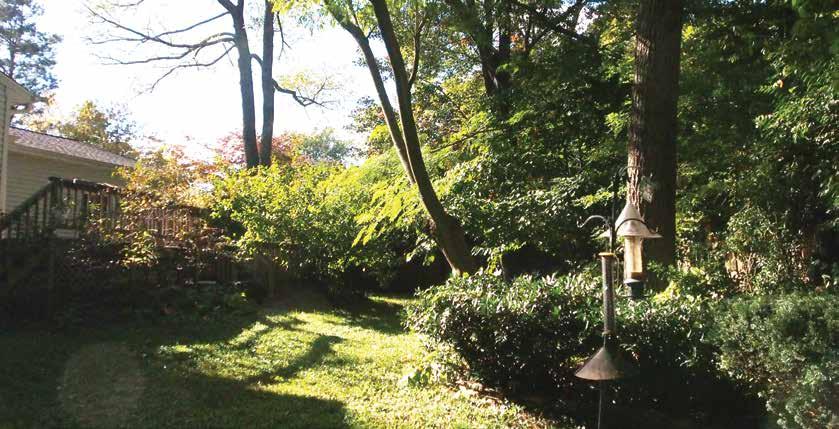
HOME EDITION
By Daniel J. Lebbin, ABC Vice President of Threatened Species
In our second “ABC Birding” installment, instead of taking readers to a birding site benefiting from ABC and partners’ conservation efforts, we journey just out the door to highlight the experience of birding from home during a global pandemic, using my yard as an example.
Lay of the Land: Our home was built in the 1950s and sits on a third-ofan-acre of land in suburban Northern Virginia. My spouse and I moved here in 2009 and now have two young children. From our house, I can hear traffic from major commuting roads, including I-66. The front yard is dominated by a pesticide-free lawn, old maple trees, a Flowering Dogwood and an Eastern Redcedar. The back and side yards feature taller trees mainly along the property’s edges, including Black Cherry, Black Walnut, and a Scarlet Oak. An emergent snag visible just outside the yard offers perches for woodpeckers and other birds. Undergrowth includes Sassafras, Eastern Redbud, Arrowwood Viburnum, Elderberry, and Spicebush. A bird bath and a seed feeder stocked with sunflower chips is visible from our inside dining area.
Focal birds: We have a typical assortment of backyard residents for eastern North America, including the Northern Cardinal, Song Sparrow, Carolina Wren, Carolina Chickadee, White-breasted Nuthatch, and Tufted Titmouse. All of these visit the feeding station. The American Goldfinch is another colorful yard star, present year-round, with males in bright canary-yellow plumage from roughly March to October. Summer breeders include the Gray Catbird, and winter brings White-throated Sparrows. We have a nice variety of woodpeckers year-round, including the Red-bellied, Downy, and, less frequently, the Hairy Woodpecker, as well as the Northern Flicker. The Pileated Woodpecker is largely absent, due to insufficient forest. The yard list really builds when migratory birds pass through in spring and fall. Although I might normally see 15 to 20 species in a single day, there were a couple of epic migration days this past spring when I observed more than 40 species. This year, I have heard or seen more than 100 species from our property, including eight new yard birds, such as the Bobolink and Olive-sided Flycatcher — two declining species that ABC works to save with partners across the Americas.
Other wildlife: A Red Fox or two patrols the neighborhood and our yard, keeping the Eastern Cottontails scarce. The Eastern Gray Squirrel is ubiquitous. Other mammals include the Eastern Chipmunk, White-tailed Deer, Common Raccoon, and Virginia Opossum. This year, I started using iNaturalist to identify insects, including large beautiful moths (such as the Imperial and Polyphemus), the Red-headed Bush Cricket, and blackand-orange insects like the Large Milkweed Bug that favor a small patch of milkweed we planted.
When to visit: Our yard provides year-round interest, and no day is the same as the next. Yard birding
ABOVE: The author’s yard. RIGHT: An American Goldfinch feeds on Black-eyed Susan seeds by the driveway, and a Northern Cardinal samples the Winterberry fruit out the back window. Photos by Daniel J. Lebbin
regularly lets you learn the local birds and their habits, and provides more chances to find something unusual. Even just a few minutes can be productive. Morning and evening are the most active times. Evening skywatching can reveal birds flying high overhead to roosting sites — including waterbirds like Great Blue Herons — that are not likely to land in or near our yard. Midday can be eventful during hawk migration, after the ground warms and thermals rise.
Conservation Activities: Indoors, the house now hosts our home office, where I coordinate various ABC bird conservation activities from Hawai‘i to Brazil, and my spouse also works in conservation in Latin America, with both of us raising two wildlife-aware elementary school students. Outdoors, we have planted native plants that support wild birds and insects, and beautify our yard. Arrowwood Viburnum produces fruits gobbled up by the Gray Catbirds, cover for passage migrants like the Common Yellowthroat, and lacey white flowers attractive to bees. Trumpet (or Coral) Honeysuckle and Cardinal Flower (both native), and a (nonnative) Silktree attract Ruby-throated Hummingbirds in late summer. American Goldfinches feed on the seeds of Black-eyed Susans and Purple Coneflowers, which we leave up through the winter, even after the plants have died back. We also leave leaf-litter in the garden beds and in the dog pen; this provides substrate for foraging Brown Thrashers and occasionally Fox Sparrows that pass through on migration. We avoid using pesticides, and Northern Flickers love foraging for ants and other invertebrates on our lawn. We don’t have cats (I am allergic), but our neighbors who do, keep theirs indoors. Neighborhood dogs and foxes keep other freeroaming cats away most of the time.
Directions: Whether you have your own yard or an apartment balcony, look out the window, and step outside if or when you can. I routinely upload my observations to eBird, so they can contribute to science and monitoring initiatives at larger scales, including breeding observations for the recent Breeding Bird Atlas project in Virginia. Modern tools available on your smart phone like eBird, Merlin, BirdCast, iNaturalist, and many others can help you get the most out of your nature observations or target key moments in the day or year to watch for birds. I use BirdCast to alert me to large nocturnal migration events in my region, and this helps decide when to focus on morning birding during migration (or maybe stay in bed). It is also helpful for deciding when to go out in the middle of the night to listen for thrushes and other nocturnal migrants flying overhead. Between midnight and 1 a.m. on May 25 this past spring, I heard more than 100 Swainson’s Thrushes call overhead in an hour, plus five Veery, and one Gray-cheeked Thrush.
Monitoring local birding channels (GroupMe texts, birding listservs, eBird alerts) provides real-time tips. For example, this spring, Washington, D.C., birders were seeing Common Nighthawks overhead one evening, indicating a movement of this species. When I saw texts about this, I went outside and soon found my own nighthawk flying overhead after a few minutes. Usually, I may see only one or two each year from my yard. I got to see several flyover Common Loons one morning using this same method, and this species was new for the yard. It can also be helpful to join a group (like the DMV Yard/Patch Birders and Naturalists group on Facebook), start a friendly competition with neighbors or colleagues to list yard birds, and participate in a local Breeding Bird Atlas project. This might help motivate, inspire, and strengthen connections while being isolated at home during the pandemic.
For more information, see: eBird: ebird.org Merlin: merlin.allaboutbirds.org BirdCast: birdcast.info
iNaturalist: inaturalist.org DMV Yard/Patch Birders and Naturalists: www.facebook.com/ groups/852736271892264/

